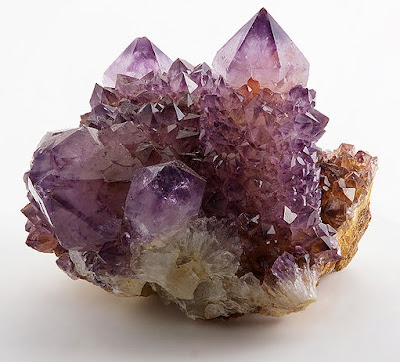Dev, Dhr. Seven, Ashley Wells, Wisdom Quarterly; Ven. Dhammika (to Constance
Sandham, Buddhist Publication Society, Wheel 342); Silveradditions.co.uk; Suprapowers.com
 |
| Amethyst quartz cluster from Magaliesburg, South Africa (wikipedia) |
 |
| Purple amethyst quartz (silveradditions.co.uk) |
 |
| The sixth chakra at the 3rd eye is violet |
The word amethyst is
Greek (ἀμέθυστος, amethustos), which means a- "not" and -methustos "intoxicated."
It was believed to
protect its wearers from intoxication.
Amethyst is the stone of St. Valentine, the master of romantic intoxication. He wore an amethyst engraved with Cupid (Mara Devaputra), his assistant.
This crystal is made up of a variety of quartz minerals (silica). When it is subjected to
intense heat, it changes from violet purple to yellow, which is referred
to as burnt amethyst.
This gemstone is beautiful and colorful, and
with a hardness of seven on the Mohs Scale, it is treasured for use
in jewellery.
 |
| Seven centers of light and sound |
Amethyst is found in South America and Africa, from Brazil, Uruguay, Bolivia, and Argentina to Namibia and Zambia. Deep purple amethysts come from Guerrero, Mexico, which are considered to be the most precious in the
world. The pale crystallized amethyst also comes from Mexico. Blue-violet amethyst is found in North Carolina, USA.
Its color corresponds to the vibration of the "third eye" (dibba cakkhu), at the agna chakra (forehead), spoken of by seers in India. Amethyst has powerfully
soothing effects on its wearers. It is believed to enhance a person's
ability to learn new ideas faster. It help steady the mind and
balancing emotional, mental, and physical states. There are other gems:
Gemstones of the Good Dharma
Ven. S. Dhammika (Australian-born Theravada monk, ordained in India, meditation instructor in Sri Lanka, now lives and teaches in
Singapore) edited by Wisdom Quarterly
 |
| A dazzling collection of sparkling gemstones (suprapowers.com) |
 |
| The Buddha reflected (nojustnut/flickr.com) |
The discourses of the historical Buddha (the ascetic Siddhartha Gautama) and his direct
disciples have been collected together into a huge body of literature
known as the "Discourse Collection" (Sutta Pitaka).
Composed of both prose and verse, much of this
literature is little known to the average Buddhist because of its great
size and because, in both style and content, it is highly
philosophical.
One selection of this literature is, however, very well
known. It is the Dhammapada ["Imprint of the Dharma"] a collection of 423 verses on select aspects of the Buddha's teachings. Its convenient size, pithy wisdom, and great beauty
has made it by far the most popular book in Discourse Collection.
Many other verses of equal relevance and appeal can be
found scattered throughout the collection of sutras that remain virtually
unknown. It may be useful, therefore, to collect some of them here, arrange them according to subject, and present them in such a
way that they may enrich the confidence (faith, conviction) and deepen understanding.
Most of these verses are the words of the Buddha; a few are attributed to enlightened disciples. But even
these reflect the spirit of the Buddha's Dharma, for it is said: "That
which is well spoken [good to speak] is the word of the Buddha" (A. IV, 164).
II. The Dharma
...6. I will teach you a Dharma,
not hearsay but to be directly seen.
Whoever discovers it and knows it,
and lives by it with mindfulness,
will transcend craving for the world.
7. Prosperity in life is plain,
decline in life is also plain:
one who loves the Dharma prospers,
one who hates the Dharma declines.
8. Thoroughly understanding the Dharma
and freed from longing through insight,
the wise one rid of all [clinging]
is calm as a pool unstirred by wind.
9. Those to whom the Dharma is clear
are not led into other doctrines;
perfectly enlightened with perfect knowledge,
10. Not by water is one made pure
though many people may here bathe [in sacred rivers],
but one in whom there is truth and Dharma,
that person is pure, one is a [real] Brahmin.
11. The path is called "straight,"
"without fear" is the destination;
the carriage is called "silent"
and its wheels are right effort.
12. Conscience is the rail and
mindfulness the upholstery,
Dharma is the driver and
right view runs ahead of it.
13. And whether it be a woman,
or whether it be a man,
whoever travels by this carriage
shall draw close to nirvana.
14. Of all the medicines in the world,
manifold and various,
there is none like the medicine of Dharma:
therefore, O disciples, drink of this.
15. Having drunk this Dharma medicine,III. The Defilements
one will be ageless and beyond death;
having developed and seen the truth,
one will be quenched, free from craving.
16. Bound by desire, tied to becoming,
fettered tightly by wrong views,
yoked to ignorance, whirled around:
thus beings wander through rebirth,
dying only to be reborn again.
17. Neither gold nor minted coins
can make the defilements disappear.
Sense cravings are enemies and killers,
hostile darts, rigid bonds.
18. Desire is agitating and deceiving,
a source of mental pain,
a net cast out by Mara [the Tempter]
to entangle and defile beings.
19. Were there a mountain made of gold,
double that would not be enough
to satisfy a single person:
know this and live accordingly. More



















































































































































































































































No comments:
Post a Comment